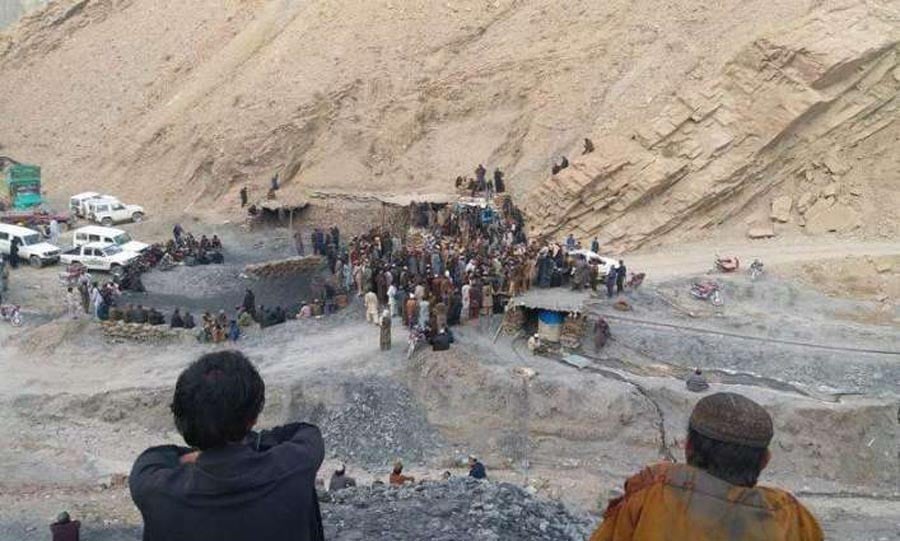
Profile of the district that sends miners across the country and yet receives them back either sick or dead

It’s evening in Khyber Pakhtunkhwa’s Shangla district. The sun is about to set. This is the usual time for evening calls for prayers in Baily Baba village. But this time the announcement from the mosque draws the attention of people towards something unusual: ‘Ali Khan’s son Jan Muhammad has been martyred in the coalmine. It has saddened the whole village’. Another mosque starts an announcement: ‘Fazal Karim’s son Sagheer Ullah has been killed in a coalmine’. Both the incidents happened in October 2018.
The temperature of Shangla district remains around 10 degree centigrade throughout the year. Thousands of tourists visit the picturesque northwestern region in the summers. Evenings are always chilly.
Normally, people go back to their homes from the mosque after the Isha prayers but that day they had to wait for additional prayers -- the funeral of Jan Muhammad and Sagheer Ullah. The village observes three days of mourning, following which there may be similar calls for funeral from the loudspeakers of the mosques.
Unfortunately, the district has very little of plain land; people have to bury their dear ones in the hills. The only crop that is grown here is maize. People are mostly associated with construction business whereas other are interested in government jobs. But that too is rare, especially considering the population pressure. It is estimated that around 60,000 people of Shangla are associated with the coalmine business.
45-year old Habib Ullah, a coalminer previously, says the graveyards of Shangla are filled with bodies of coalminers. "We are burying at least three to four people in the terrains of Shangla every week." Habib Ullah could not continue his job due to his ill health. "People start sending money to their families as soon as they start working in coalmines. As soon as the flow of money stops, the family realises their dear one has become a victim of the coalmine. It would not be incorrect to say that each family is a victim of coalmine business."
Walindar, a nearby town of Baily Baba village, which was completely destroyed by the massive floods in 2010, has a similar story. Thousands of its inhabitants are working in coalmines of Darra Adamkhel, Sindh and Quetta.
Khalid Khan, a school teacher in Walindar, says, "People are almost sure about the death of whoever starts working in a coalmine. Those who survive are the ones who leave work because of different chest-related diseases." He adds the person returning from mines is like a living ghost.
The owner or contractors are not following the age limit and other rules and regulations. Sometime an eight year-old-son can be found working with his fifty year old father. Generally the kids whose age ranges from 8-17 are busy in collecting coal at the entrance of the mine. People from Shangla go to work as labour, both as individuals as well as in families. Fathers sometimes take their sons along who are a little grown up like 8-10 years but no woman.
More than 100 advisers from Shangla are working in different coalmines. They are called ‘Jamadaar’ in the native language. Ali Akbar, who has been a coalminer himself, says these Jamadaar are responsible for taking thousands of youngsters from Shangla and forcing them into adopting this dangerous job. Contrary to common perception, the contractors don’t belong to Shangla district. Jamadaar is the contact person of contractors -- the guarantor for both contractor and worker. Sometimes, the workers have to get advance money from the contractor; it’s the Jamadaar who guarantees they would return it.
Khalid Khan says they have launched a campaign for the registration of workers with the labour ministry and EOBI (Employees Old Age Benefit Institution), but the Jamadaar aren’t taking those registered workers along. "If someone gets killed in a coalmine, the Jamadaar arranges ambulance and coffin for the deceased; however, for a registered worker, his family is supposed to be paid around seven hundred thousand rupees," says Khan. "That is why contractors aren’t interested in hiring registered workers -- to avoid having to pay huge compensation".
The scenic valley lacks job opportunities and people usually feed their families through labour work. District councilor, Gulab Khan, says that each region has its own job trends. "The people of neighbouring Dir district prefer to go abroad to the Middle Eastern countries for jobs. But our people go to the valley of death," says Khan. He says the reason people prefer to opt for the "dangerous profession" is the lucrative wages. "If the plant is working at full capacity, a coalminer get around Rs50,000 a month, whereas a normal labourer gets around Rs6000 for doing other jobs. These labourers are paid every fifteen days, twice a month.
"Ninety percent of Shangla’s residents are suffering from chest diseases. Fifty percent of our graveyards are filled with coalmine ‘martyrs’," says Gulab Khan.
Each of these miners has different domestic issues. Knowing the health hazards, they still opt for the dangerous work because they have to arrange for the weddings of their brothers and sisters which require a good amount of cash.
Also read: Where safety comes last
Sohail Khan works at Gulab Khan’s Hujra. He says his brother also met with the same fate -- killed in a coalmine. "Usually we can’t even pay a final look at our dear ones because their bodies are burnt," he says.
"Our mission is to provide good jobs to the people. They contact us because we are paying well," says Jameel Khan, a local Jamadaar. "Usually, the workers get under a huge debt of the contractors who then force them opt for the dangerous task to get their money back," says Jameel Khan. "This is how the business of coalmines goes on."